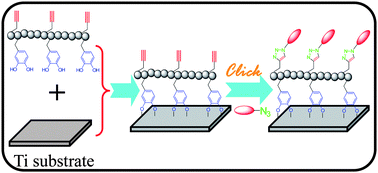Poly(dopamine acrylamide)-co-poly(propargyl acrylamide)-modified titanium surfaces for ‘click’ functionalization†
Abstract
Poly(dopamine acrylamide)-co-poly(propargyl acrylamide) (PDA-co-PPA)

* Corresponding authors
a
Department of Chemical & Biomolecular Engineering, National University of Singapore, Kent Ridge, Singapore
E-mail:
cheket@nus.edu.sg
b
School of Chemistry and Chemical Engineering, Southeast University, Jiangning District, Nanjing, Jiangsu Province, P.R. China
E-mail:
fu7352@seu.edu.cn
Poly(dopamine acrylamide)-co-poly(propargyl acrylamide) (PDA-co-PPA)

 Please wait while we load your content...
Something went wrong. Try again?
Please wait while we load your content...
Something went wrong. Try again?
L. Q. Xu, H. Jiang, K. Neoh, E. Kang and G. D. Fu, Polym. Chem., 2012, 3, 920 DOI: 10.1039/C2PY00552B
To request permission to reproduce material from this article, please go to the Copyright Clearance Center request page.
If you are an author contributing to an RSC publication, you do not need to request permission provided correct acknowledgement is given.
If you are the author of this article, you do not need to request permission to reproduce figures and diagrams provided correct acknowledgement is given. If you want to reproduce the whole article in a third-party publication (excluding your thesis/dissertation for which permission is not required) please go to the Copyright Clearance Center request page.
Read more about how to correctly acknowledge RSC content.
 Fetching data from CrossRef.
Fetching data from CrossRef.
This may take some time to load.
Loading related content
